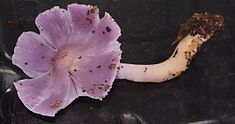- Humidicutis lewelliniae
-
Humidicutis lewelliniae 
H. lewelliniae
Hazelbrook, New South WalesScientific classification Kingdom: Fungi Division: Basidiomycota Class: Agaricomycetes Order: Agaricales Family: Hygrophoraceae Genus: Humidicutis Species: H. lewelliniae Binomial name Humidicutis lewelliniae
(Kalchbr.) A. M. YoungHumidicutis lewelliniae Mycological characteristics 
gills on hymenium 
cap is umbonate 
hymenium is adnexed 
stipe is bare 
spore print is white 
ecology is saprotrophic 
edibility: unknown Humidicutis lewelliniae, commonly known as the mauve splitting wax-cap, is a gilled fungus of the waxcap family found in wet forests of eastern Australia and New Zealand. The small mauve- or lilac-coloured mushrooms are fairly common and appear in moss or leaf litter on the forest floor in autumn, and are saprobic. The key distinguishing feature is the splitting of the cap dividing down the middle of the individual gills.
Contents
Taxonomy
It was initially described as Hygrophorus lewelliniae by Hungarian mycologist Károly Kalchbrenner in 1882,[1] and later as Hygrocybe lewelliniae by Brittlebank in 1940, before being placed in the genus Humidicutis by Australian mycologist Tony Young in 1997.[2] The generic name derives from the Latin humidus "moist" and cutis "skin", referring to its moist cap. The original holotype specimen had been collected on 14 June 1880 in the vicinity of Western Port in Victoria by a Miss M.R. Lewellin and sent by Ferdinand von Mueller to Kalchbrenner in Budapest. It was likely destroyed in the First World War,[3] although a watercolour of it by the collector survives and is located in the National Herbarium of Victoria. It has been compared with collections made by E. J. H. Corner of a Mycena rimosacuta in Borneo and found to be the same species. It may be that Humidicutis mavis is merely a white-coloured form of this species.[4]
Description
The mauve splitting waxcap is a small mushroom with an umbonate cap 3–6.5 centimetres (1⅓–2½ in) in diameter, initially conical and later flattening to almost flat. It is smooth and mauve or lilac in colour with a greyish boss. The cap is textured with radial fibres, along which it may split, with the gills dividing between the split. The lilac stipe is 3–7 cm (1⅓–2½ in) high and 0.4–0.8 cm thick and may be tinged yellow at the base. The lilac gills are adnexed or free, and thick or distant with even margins. The spore print is white and the hyaline spores are more or less oval, measuring around 5.5 x 9 μm.[5]
Distribution and habitat
Saprotrophic, this species is fairly common.[6] Fruiting bodies appear in autumn and winter (March to August) with some records from October, in moss or among leaf litter in wet sclerophyll forest or rainforest in temperate, subtropical or tropical climates. It also appears in sandy areas.[6] It has been recorded from southeastern Queensland, eastern New South Wales, Victoria and Tasmania, as well as New Zealand and from Mount Kinabalu in Sabah. Although not recorded from North Queensland, it is predicted to occur there.[5]
References
- ^ Kalchbrenner, K (1882). "Definitions of some new Australian fungi". Proceedings of the Linnean Society of New South Wales 7: 104–06.
- ^ Young AM, Wood AE (1997). "Studies on the Hygrophoraceae (Fungi, Homobasidiomycetes, Agaricales) of Australia". Australian Systematic Botany 10 (6): 911–1030. doi:10.1071/SB96005.
- ^ Young, p. 9
- ^ Young, p. 44
- ^ a b Young, p. 42
- ^ a b Grey P (2005). Fungi Down Under:the Fungimap Guide to Australian Fungi. Melbourne: Royal Botanic Gardens. p. 41. ISBN 0-646-44674-6.
Cited text
- Young, A.M. (2005). Fungi of Australia: Hygrophoraceae. (Australian Biological Resources Study) CSIRO, Canberra, ACT. ISBN 0-643-09195-5.
Categories:- Hygrophoraceae
- Fungi native to Australia
- Fungi of New Zealand
Wikimedia Foundation. 2010.
